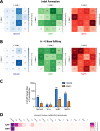PAM-flexible genome editing with an engineered chimeric Cas9
- PMID: 37794046
- PMCID: PMC10550912
- DOI: 10.1038/s41467-023-41829-y
PAM-flexible genome editing with an engineered chimeric Cas9
Abstract
CRISPR enzymes require a defined protospacer adjacent motif (PAM) flanking a guide RNA-programmed target site, limiting their sequence accessibility for robust genome editing applications. In this study, we recombine the PAM-interacting domain of SpRY, a broad-targeting Cas9 possessing an NRN > NYN (R = A or G, Y = C or T) PAM preference, with the N-terminus of Sc + +, a Cas9 with simultaneously broad, efficient, and accurate NNG editing capabilities, to generate a chimeric enzyme with highly flexible PAM preference: SpRYc. We demonstrate that SpRYc leverages properties of both enzymes to specifically edit diverse PAMs and disease-related loci for potential therapeutic applications. In total, the approaches to generate SpRYc, coupled with its robust flexibility, highlight the power of integrative protein design for Cas9 engineering and motivate downstream editing applications that require precise genomic positioning.
© 2023. Springer Nature Limited.
Conflict of interest statement
P.C. and J.M.J. are listed as inventors for US Patent Application 17/841,639 entitled: “Applications of Recombined ScCas9 Enzymes for PAM-free DNA Modification.” B.P.K is an inventor on patents and/or patent applications filed by Mass General Brigham that describe genome engineering technologies. B.P.K. is a consultant for EcoR1 capital, and is a scientific advisor to Acrigen Biosciences, Life Edit Therapeutics, and Prime Medicine. B.P.K. has a financial interest in Prime Medicine, Inc., a company developing therapeutic CRISPR-Cas technologies for gene editing. B.P.K.‘s interests were reviewed and are managed by MGH and MGB in accordance with their conflict-of-interest policies. The remaining authors declare no competing interests.
Figures



Update of
-
PAM-Flexible Genome Editing with an Engineered Chimeric Cas9.Res Sq [Preprint]. 2023 Mar 7:rs.3.rs-2625838. doi: 10.21203/rs.3.rs-2625838/v1. Res Sq. 2023. Update in: Nat Commun. 2023 Oct 4;14(1):6175. doi: 10.1038/s41467-023-41829-y. PMID: 36945419 Free PMC article. Updated. Preprint.
References
-
- Mojica FJM, Díez-Villaseñor C, García-Martínez J, Almendros C. Short motif sequences determine the targets of the prokaryotic CRISPR defence system. Microbiology. 2009;155:733–740. - PubMed
Publication types
MeSH terms
Substances
Grants and funding
LinkOut - more resources
Full Text Sources
Research Materials
Miscellaneous

